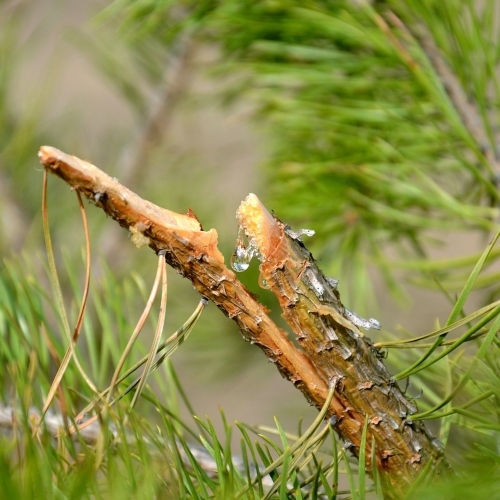How to Deal with Tree Stress: A Comprehensive Guide
Understanding and Managing Tree Health in Your Landscape
Are your trees showing signs of distress? Many homeowners struggle to identify and address tree stress , which can lead to long-term damage or even tree loss. In this comprehensive guide, we’ll explore the symptoms, causes, and solutions for tree stress, helping you maintain a healthy and vibrant landscape.
Key Takeaways:
- Learn to recognize common signs of tree stress
- Understand the various causes of tree stress
- Discover effective treatments and prevention methods
- Know when to call a professional arborist
Signs and Treatments of Tree Stress

Stressed Tree Leaves Displaying Yellowing and Brown Spots
Tree stress can manifest in various ways. By familiarizing yourself with these symptoms, you can take prompt action to protect your trees .
1. Cracks and Splits
While minor splits may heal naturally, severe injuries require professional attention. If a crack affects more than 50 percent of the tree, removal might be necessary.
Treatment:
- Clean the wound to prevent infection
- Monitor small cracks for healing progress
- Consult an arborist for large or worsening cracks
2. Broken or Damaged Branches
Storm damage can cause significant stress to trees. Proper pruning is crucial for recovery.
Treatment:
- Remove broken branches promptly
- Use clean, sharp tools to make proper cuts
- Consider cabling or bracing for added support
3. Loss of Leaves
Leaf loss can indicate various issues, depending on the pattern:
- Trees Budding Without Leaves: Possible bud damage or nutrient deficiency
- Leaves Missing on One Side: Potential root damage or pest infestation
- Missing Leaves on Top: Possible lightning strike or severe nutrient deficiency
Treatment:
- Conduct a soil test to check for nutrient imbalances
- Implement a proper fertilization program
- Treat for pests if necessary
4. Leaning Trees
While gradual leaning is often natural, sudden changes after storms can indicate root damage or instability.
Treatment:
- Assess the severity and cause of the lean
- Consider soil compaction relief or root zone improvements
- In severe cases, tree removal may be necessary for safety
5. Discoloration or Early Loss of Leaves
Premature leaf drop or discoloration can signal various stressors, including disease, pests, or environmental factors.
Treatment:
- Identify the underlying cause (e.g. drought, overwatering, disease)
- Adjust watering practices if necessary
- Apply appropriate treatments for identified pests or diseases
6. Fungi or Mushrooms
While some fungi are beneficial, others can indicate decay or root issues.
Harmful fungi to watch for:
Treatment:
- Identify the type of fungi present
- Improve soil drainage and aeration
- Remove visible fungal growths
- Consult an arborist for severe infestations
Causes of Tree Stress
Pine Tree Resin Dripping from Bark – Image by Mareefe on Pixabay
Understanding the root causes of tree stress is crucial for effective prevention and treatment.
1. Environmental Factors:
- Extreme weather events (storms, droughts, floods)
- Soil compaction
- Changes in soil grade or construction damage
2. Human-Induced Stress:
- Air pollution
- Salt damage from deicing
- Improper pruning or overpruning
3. Biological Stressors:
- Pest infestations
- Diseases (bacterial, fungal, viral)
- Competition from nearby plants
4. Mechanical Injuries:
- Lawnmower or weed trimmer damage
- Improper staking or guy-wires
- Vehicle impacts
The Best Practices for Dealing with Tree Stress
An Arborist Now Expert Performing Tree Maintenance
- Regular Inspections: Conduct visual checks of your trees at least twice a year.
- Proper Watering: Maintain consistent soil moisture, especially during dry periods.
- Mulching: Apply organic mulch around the bases of trees to retain moisture and regulate soil temperature.
- Fertilization: Use a balanced, slow-release fertilizer based on soil test results.
- Pruning: Remove dead, diseased, or damaged branches to promote healthy growth.
- Pest Management: Implement integrated pest management strategies to control harmful insects and diseases.
- Soil Care: Aerate compacted soils and add organic matter to improve structure and nutrient content.
- Protection: Shield trees from mechanical damage and extreme weather conditions when possible.
When to Call a Professional Arborist
While many tree care tasks can be handled by homeowners, certain situations require expert intervention:
- Large-scale pruning or removal
- Complex pest or disease issues
- Structural concerns (e.g. severe leaning, large cracks)
- Lightning strike damage
- Root zone disturbances
For those in the San Francisco Bay Area, contact Arborist Now for professional tree care services. Our team of certified arborists can provide expert diagnosis and treatment for all your tree health needs.
Remember, early intervention is key to managing tree stress effectively. By staying vigilant and proactive in your tree care practices, you can ensure a healthy, beautiful landscape for years to come.




